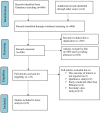Systematic review and meta-analysis of women's awareness of obstetric fistula and its determinants in Ethiopia
- PMID: 37275209
- PMCID: PMC10235548
- DOI: 10.3389/fgwh.2023.1151083
Systematic review and meta-analysis of women's awareness of obstetric fistula and its determinants in Ethiopia
Abstract
Background: Although obstetric fistula has been extensively eliminated in high-income countries due to comprehensive obstetric health care services, in developing countries including Ethiopia, many women and girls are still silently suffering from obstetric fistula due to early marriage, poor socioeconomic status, lack of access to skilled birth attendants, and limited awareness of obstetric fistula.
Objective: To determine the magnitude of women's awareness of obstetric fistula and its contributing factors in Ethiopia.
Methods: To perform this analysis, we strictly adhered to the Preferred Reporting Items for Systematic Review and Meta-Analysis (PRISMA) recommendations. To evaluate publication bias, we employed an Egger's test and an eye assessment of the funnel plot's symmetry. To look for signs of study heterogeneity, the Cochrane Q-test and I2 statistics were used. A Microsoft Excel spreadsheet was used to extract the data, and STATA version 14 was used to analyze it.
Results: A total of six studies involving 3,024 women were included. The pooled prevalence of women's awareness of obstetric fistula in Ethiopia was 41.24% (95% CI; 32.94%-49.54%). Urban residence (AOR = 2.32, 95% CI: 1.40-3.85), giving birth at a health institution (AOR = 2.84, 95% CI: 1.92-4.21), having secondary or above educational status (AOR = 3.27, 95% CI: 2.15-4.97), receiving antenatal care follow-up (AOR = 2.73, 95% CI: 1.71-4.35), and participation in pregnant women's conferences (AOR = 4.64, 95% CI: 2.88-7.49) were factors associated with good awareness of obstetric fistula in women in Ethiopia.
Conclusion: The pooled prevalence of women's awareness of obstetric fistula was low. Urban residence, giving birth at a health institution, having secondary and above educational status, having antenatal care follow-up, and participating in pregnant women's conferences were factors associated with women's awareness of obstetric fistula. Therefore, enhancing women's awareness of obstetric fistula and promoting institutional delivery and antenatal follow-up is recommended. Furthermore, policymakers and stakeholders should empower women and pay particular attention to the neglected but important public health problem that is obstetric fistula.
Keywords: Ethiopia; meta-analysis; obstetric fistula; systematic review; women's awareness.
© 2023 Melis and Mose.
Conflict of interest statement
The authors declare that the research was conducted in the absence of any commercial or financial relationships that could be construed as a potential conflict of interest.
Figures




Similar articles
-
Knowledge of obstetric fistula and its associated factors among women of reproductive age in Northwestern Ethiopia: a community-based cross-sectional study.BMC Womens Health. 2022 Nov 23;22(1):467. doi: 10.1186/s12905-022-02001-8. BMC Womens Health. 2022. PMID: 36419045 Free PMC article.
-
Pregnant women's knowledge, attitude, and practice towards COVID-19 infection prevention in Ethiopia: A systematic review and meta-analysis.PLoS One. 2022 Oct 26;17(10):e0276692. doi: 10.1371/journal.pone.0276692. eCollection 2022. PLoS One. 2022. PMID: 36288349 Free PMC article.
-
Prevalence of completion of maternity continuum of care and its associated factors in Ethiopia: a systematic review and meta-analysis.BMJ Open. 2022 Nov 21;12(11):e062461. doi: 10.1136/bmjopen-2022-062461. BMJ Open. 2022. PMID: 36410822 Free PMC article.
-
WOMEN's Knowledge of Obstetric Danger signs in Ethiopia (WOMEN's KODE):a systematic review and meta-analysis.Syst Rev. 2019 Feb 25;8(1):63. doi: 10.1186/s13643-019-0979-7. Syst Rev. 2019. PMID: 30803443 Free PMC article.
-
Women's knowledge towards neonatal danger signs and its associated factors in Ethiopia: a systematic review and meta-analysis.BMC Pediatr. 2020 May 14;20(1):217. doi: 10.1186/s12887-020-02098-6. BMC Pediatr. 2020. PMID: 32408874 Free PMC article.
Cited by
-
Knowledge of obstetric fistula and contributing factors among reproductive-age women in Ethiopia: a systematic review and meta-analysis.AJOG Glob Rep. 2024 Nov 28;5(1):100426. doi: 10.1016/j.xagr.2024.100426. eCollection 2025 Feb. AJOG Glob Rep. 2024. PMID: 39810942 Free PMC article.
-
Multilevel analysis of individual and community factors of awareness of obstetric fistula among women of childbearing age in Nepal: analysis of recent Nepal Demographic and Health Survey 2022 data.BMJ Open. 2024 Sep 10;14(9):e088842. doi: 10.1136/bmjopen-2024-088842. BMJ Open. 2024. PMID: 39260862 Free PMC article.
References
-
- Statement P. Position Statement Obstetric Fistula. (2016);(April 1994):2016–8. Available at: www.internationalmidwives.org
-
- World Health Organization W. Obstetric fistula. Available at: https://www.who.int/news-room/facts-in-pictures/detail/10-facts-on-obste... (Cited 1BC April 5).
Publication types
LinkOut - more resources
Full Text Sources

